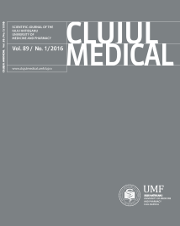Development of new 5-chromenyl-2,4-thiazolidinediones as antimicrobial agents
DOI:
https://doi.org/10.15386/cjmed-509Keywords:
chromone, 2, 4-thiazolidinedione, antibacterial, antifungalAbstract
Background and aims. In the context of the increasing phenomenon of microbial resistance to usual drugs, the development of new treatment strategies and new therapeutic protocols is a constant need. Thiazolidinedione and chromone represent two important scaffolds in medicinal chemistry due to their large pharmacological applicability.
Methods. We synthesized a new 5-(chromene-3-yl)methylene-2,4-thiazolidinedione starting from 6,8-dichloro-4-oxo-4H-chromene-3-carbaldehyde. Then, by treating with different α-bromoalkylarylketones, we obtained N-substituted derivatives. All new compounds were investigated for their antimicrobial potential, using the diffusion method, against Listeria monocytogenes ATCC 13932, Staphylococcus aureus ATCC 49444, Escherichia coli ATCC 25922, Salmonella typhimurium ATCC 14028 and Candida albicans ATCC 10231. Three concentrations, 10 mg/ml, 5 mg/ml and 1 mg/ml of compounds were used. The results were evaluated by the measurement of the inhibition zone diameters and compared to those of gentamicin and fluconazole respectively, as reference drugs.
Results. All new synthesized compounds were characterized using physico-chemical and spectrometric methods. They displayed modest to good antimicrobial activity. New molecules 8, 9 and 10 may represent promising candidates, showing zone inhibition diameters superior to those of reference drugs.
Conclusions. This work presents chemical synthesis, characterization and investigation of the antibacterial and antifungal potential of 5-(chromene-3-yl)methylene-2,4-thiazolidinedione derivatives, which may be worthy of future research for designing new chemical entities.Downloads
Additional Files
Published
How to Cite
Issue
Section
License
The authors are required to transfer the copyright of the published paper to the journal. This is done by agreeing to sign the Copyright Assignment Form. Whenever the case, authors are also required to send permissions to reproduce material (such as illustrations) from the copyright holder.

The papers published in the journal are licensed under a Creative Commons Attribution-NonCommercial-NoDerivatives 4.0 International License.

